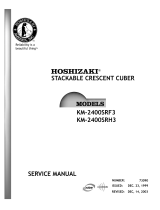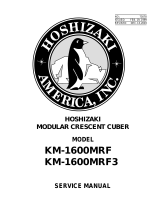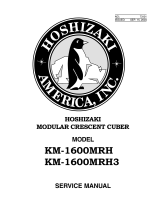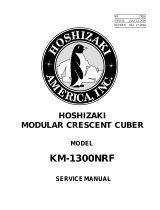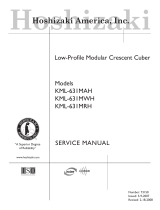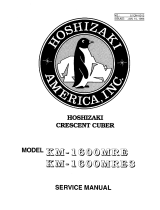
20
a) Freeze Cycle Diagnosis: Conrm Comp, FM*, FMR, and PM continue. Conrm
that FM and LLV energize. Conrm WRV opens. Next, conrm HGV and X10 relay
de-energize. During the rst 5 min. of freeze, conrm evaporator is cooling. If not,
conrm WV de-energized (not leaking by), HGV de-energized (not bypassing), LLV
and FM energize, TXV and HM operate correctly, WRV opens, Comp is efficient,
and refrigerant charge is correct. See "VIII.A. Specication and Performance Data
Sheets."
b) Comp, FM*, and FMR Diagnosis: If Comp, FM*, and FMR de-energize once freeze
begins, check that appliance has not shut off on HPS ("POWER OK" LED off). If so,
check "3)b) HPS Diagnosis" above. If CB "POWER OK" LED is on, check for 115VAC
at CB K1 #1 (V) or #9 (V) to neutral (W). If 115VAC is not present and LED 1 is on,
replace CB. If 115VAC is present, check for 115VAC at CR or MC coil. If 115VAC is
present, check CR or MC coil and contact continuity. Replace as needed. If CR or
MC is okay, check Comp start relay and start and run capacitors. Next, check Comp
motor winding continuity. If Comp is energized but evaporator is not cooling, check
for an inefficient Comp. See "VIII.A. Specication and Performance Data Sheets."
FM* Diagnosis: If Comp is energized but FM* is not, check CB K1 #1 (V) and #9
(V) wiring circuit for loose connection. If connections are good, check FM* capacitor,
motor winding, and blade for binding.
FMR Diagnosis: If Comp is energized but FMR is not, check for 115VAC at the FMR
junction box. If 115VAC is not present, check icemaker wiring connections. If 115VAC
is present, check for voltage at condenser unit. If115VAC is not present, check eld
wiring connections. If 115VAC is present, check FMR capacitor, motor winding, and
fan blade for binding.
c) WV and HGV Diagnosis: If WV is energized, check for 115VAC at CB K1 #6 (O) to
neutral (W). If 115VAC is present after PM energizes in harvest cycle, replace CB.
If 115VAC is not present, replace WV (bypassing). If HGV did not de-energize at
the end of harvest, check for 115VAC at CB K1 #2 (P) to neutral (W). If 115VAC is
present 50 sec. after PM energizes, replace CB. If 115VAC is not present, replace
HGV (bypassing).
d) PM Diagnosis: Conrm water is owing over evaporator from PM and not WV. If PM
de-energizes once freeze begins, check for 115VAC at CB K1 #4 (R) to neutral (W).
If 115VAC is not present, replace CB. If 115VAC is present and PM is de-energized,
check for 115VAC at control switch #5 (W/R) to neutral (W). If 115VAC is present at
CB K1 #4 (R) and not at control switch #5 (W/R), check control switch continuity
between #5 (W/R) and #4 (R). Replace as needed. If 115VAC is present at control
switch #5 (W/R) to neutral (W), check PM capacitor and motor winding continuity.
e) FM and LLV Diagnosis: If FM or LLV does not energize, check for 115VAC at CB
K1#3 (BK) to neutral (W). If 115VAC is not present, replace CB. If 115VAC is present:
For FM, check capacitor, motor winding, and blade for binding.
For LLV, check coil voltage and continuity.




















